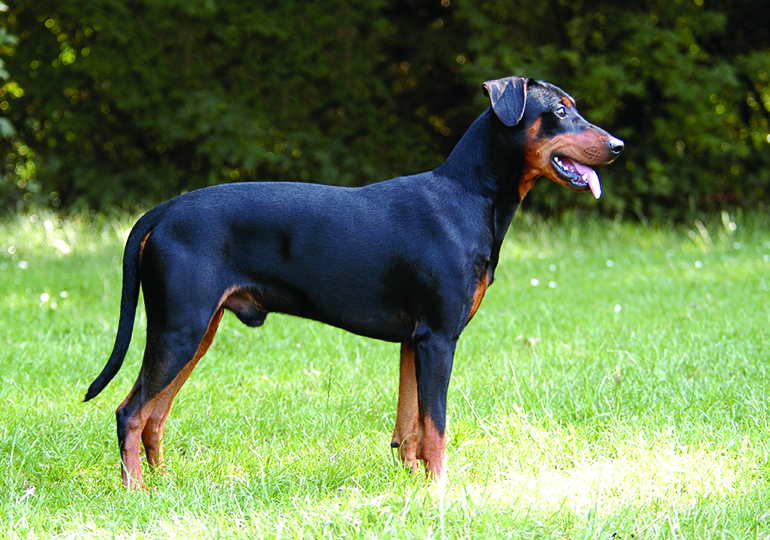
GROUP 6 - UTILITY
The German Pinscher (original name Deutscher Pinscher, FCI No. 184) is a medium-sized breed of dog, a Pinscher type that originated in Germany. The breed is included in the origins of the Dobermann, the Rottweiler, the Miniature Pinscher, the Affenpinscher, the Standard Schnauzer (and, by extension, the Miniature Schnauzer and Giant Schnauzer).
The source of the German Pinscher can be traced back to 1836. Pinschers were used as guardians for coaches. They also lived in homesteads where they were used to kill vermin, a job they did by instinct, as such behaviour did not need to be trained into the breed. Even today you can observe German Pinschers searching for and finding rats in open areas and in homes. This high prey drive is a good reason not to leave a German Pinscher off lead outside of a fenced area.
From 1950 to 1958, no litter had been registered. Credit is attributed to Werner Jung for collecting several of the breed in 1958 to continue the German Pinscher as we know the breed today.
The breed is rising in numbers in the U.S., mainly due to their full acceptance to AKC in 2003. In Australia, the breed is established with a rise in popularity becoming evident. (1)
Well balanced, smooth coated, medium size with elegant and flowing outlines but strong and well muscled. (2)
Height at the withers: 43 – 48 cms (2)
High spirited and self possessed. Alert, good natured, playful. Loyal, watchful and fearless. (2)
A well-bred German Pinscher will be a loving companion with an even temperament. (1)
German Pinschers are very energetic working dogs, in many cases requiring several hours of exercise a day. Accordingly, a large, securely fenced yard is highly recommended for anyone considering the breed as a pet and the owner to be mindful of training them appropriately. Socialization from puppyhood is a must, as high prey drive is common in the breed so in a city environment they need to learn to control their impulses. This does, however, make them a great fetch companion. (1)
You can find German Pinschers in the conformation ring, at obedience rallies or agility trials, and at work in tracking. He also works as a service dog, therapy dog, and as a pampered pet, who enjoys the comforts of family life. He can be assertive and overbearing, and he'll take over your heart and home in a matter of seconds. Don't kid yourself: he needs a firm, experienced owner who is consistent in training and good at establishing rules right from the beginning. (3)
Due to the small gene pool of the German Pinscher, breeders should health test their dogs for hereditary cataracts, hip dysplasia and elbow dysplasia, von Willebrand disease, thyroid disorder, and with the increased incidences of cardiac disease, due to irresponsible breeding practices, German Pinschers suspect for heart issues should be removed from all breeding programs. (1)
Life expectancy is 12 – 14 years.
Now you know a little about the German Pinscher you may have think that this is the dog for you. Before you make a decision, please make contact with the breed club or your State controlling body for purebred dogs. They will be able to give you information about available puppies and also suggest dog shows where you can see the breed and speak to breeders. In this way you will gain a better perspective of the German Pinscher and its needs and whether this breed would suit your lifestyle.
